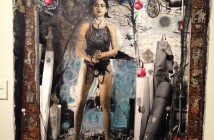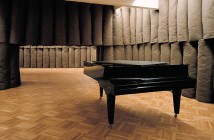
I want to believe in ghosts. I want a trace to dwell in the intimate places of someone’s life after she has died. I want these spaces to in some small way to always belong to her; for emotions and events to permeate the solid structures of inhabitance, so that a house could testify of its former residents.
Angela Strassheim’s ‘Evidence Series’ makes visible this residual remnant, the grim incarnation of unhappy ghosts. Strassheim meticulously researches a violent crime and then seeks out the current residents who are often completely unaware of what gristly tragedy has occurred in their own living room, bedroom, or kitchen. She then uses a forensic chemical luminescence called "Blue Star" that incandesces upon contact with trace amounts of blood, particles which remains in a permeating porous surface long after the removal of visible evidence.
Here, in Evidence No. 10, what appears to be glowing paint on this column is actually a short lived chemical process that illumes an invisible crime scene lurking under the domestic interior. The children’s portraits float darkly showing a new life that exists like a membrane stretched over the old. The darkened room looks banally picturesque, chillingly indifferent. The room is austere and feels unnerving in the absence of its inhabitants. The unease evinced in the slightly ajar door. Angela Strassheim retrieves space from its indifference to adumbrate the trace of an irreversible moment, a moment that for many may be willfully repressed. The unwavering gaze of her extended exposures is blunt and unflinching. The dim room laid bare renders the palpable uneasiness of lives that exist in such proximity to death, a thin veneer of domesticity hung over the momento mori of a murder scene.
Angela Strassheim’s work illumes how a place can remain silently haunted. The ghastly is made manifest as she coerces the room to remember. This is the logic of monuments, to persist as testimony to an event after it risks being forgotten. In personal lives these remembrances take the form of fragile ephemera, instead of brass plaques or commemorative obelisks one takes photographs.
The oft-touted claim that photography is a mere copy of reality is at the forefront of Strassheim’s work. Evidence No. 10, is a sinister doppelgänger, a real that exists beneath what can be seen by the naked eye. It echoes the forensic photographs that were likely taken directly after the crime occurred. Similar to John Baldessari’s Crowds with Shape of Reason Missing, the pivotal piece of narrative is absent. The crime’s full horror is only referenced; instead we are shown the space where an oblivious normalcy has returned. Life precariously unfolds atop of a dark history. It is a photograph of the trace of a trace of an event, an event after most have moved on. The domestic scene is reified as evidence through photography, but also tells of the amnesia of space. Through Strassheim’s work we are voyeurs to the sinister withheld secrets that could lurk in any home.
•••
Image Information: Angela Strassheim, Evidence No. 10, 2009
Pigment print
Every Friday, BR&S will publish a selected work from Art for Breakfast.
Subscribe to wake up to Art for Breakfast in your inbox!



